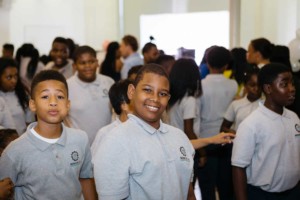Naming the Theories in Use

Theories have experience, they define causality, they help human beings create agreements and move forward.
Harvard professor Clay Christensen explained how human beings use theories to address problems after receiving a lifetime achievement award at the Agilix Personalized Learning Summit (#PLS2015) in Provo on Wednesday.
Called by the Secretary of Defense, Christensen found himself presenting to four dozen highest ranking military officers in the country. But he wasn’t sure why since he, by his own admission, didn’t know zip about defense. The Harvard prof outlined his theory of the innovator’s dilemma where innovation often outstrips the ability of traditional markets to adopt it leaving room for new entrants to serve non-consumers with inexpensive new products.
In this and hundreds of other conversations, Christensen observed that his theory about disruptive innovation gave wide ranging incumbents a useful language to discuss how the world was changing. Theories create shared understanding and an opportunity to build consensus on a path forward.
After a wonderful tribute to Clay’s contributions, a graduate student at BYU asked me, “What other theories are being applied in education?” That may be the best question of the year and one that every school and district leadership team should ask themselves.
As David Sundahl, who works with Christensen, said, “Naming the theories at work is critical to understanding any situation.”
What theories are being applied to public education? Education theorists are far better suited to answer this question, but a few theories that appear to be at work include:
- Theories of preparedness (the job-to-be-done by K-12)
- College prep-for-all is a dominant theory embraced in the last ten years but it’s based on an old credit-based definition including the path to calculus.
- Selective sports for a few dictates the size, schedule, location, and policies of most U.S. secondary schools.
- Theories of juvenile justice (incarceration rather than education) impact many young people.
- Organizational theories (how school districts work)
- Common in public delivery systems is what Jane Jacobs called the Guardian Syndrome based on loyalty, hierarchy, and tradition. She suggests the alternative Commercial System values competition, initiative and inventiveness. Conflicts in public education are often a clash of these competing but unexpressed value systems.
- Similarly, Steven Hodas describes the District Operating System (DOS), the web of systemic procedural practice that results from unexamined sedimentary layers of policies and traditions that become “the way we do things here.” He notes that the craft-based practice of school staff are very different from those of central DOS workers. Both effectively resist top down initiatives and efforts to promote what he calls dynamism, which is an openness to new ideas and an embrace of change when change is called for.
- Theories about complex systems (how this all gets resolved community by community)
- One Best System: many educators believe in common schools and see alternatives as an attack on public education.
- Portfolio of options: most urban areas benefit from multiple operators providing alternative visions of education.
- Hybrid approaches, including Compact Cities, offer a mixture of district and charter schools with many options.
- Theories of human development (how people learn)
- Freud’s psychosexual, Erikson’s psychosocial, Vygotsky’s sociocultural, Maslow’s hierarchy, and Piaget’s stages of cognitive development all represent grand theories of human development.
- Competing philosophies of education include perennialism (teacher and curriculum centered), progressivism (student-centered), critical thinking, and democratic education.
- Despite many theories of development, 200 year old Prussian theories of management still apply to the basic organization of schools with age cohorts progressing through bodies of content to earn time-based credits.
- Blended and personalized learning is the emerging pedagogical hunch (advanced by both Christensen Institute and Getting Smart).
While this list is illustrative more than exhaustive, Michael Horn of the Christensen Institute, notes that many theories of these theories have limitations in that they haven’t progressed to the point of identifying causality to explain why what they predict should occur. They aren’t adequately predictive to provide guidance to say, “If in this situation, then doing X will cause the right results, but in this circumstance, do Y instead.” (Disruptive innovation, on the other hand, has proven rather robust across many sectors over several economic cycles.)
As Clay argued in forward to Horn’s new book, blended learning is a paradigm shift that renders past limitations moot. Personalized is an early attempt to build on and unify those pedagogical theories to say different students have different needs at different times, and as a result, simply following the prescriptions from the prior theories regardless of desired learning outcome or the particular student is what leads to some students doing well, but many not. Horn adds, “Personalized learning says there’s wisdom in the various competing pedagogical theories and the key is to deploy the right element at the right time.”
Whether you buy our grand unifying theory of personalized learning, the important lesson is to be explicit about the theories at work to build shared understanding. And, if Christensen is right, better theory leads to better outcomes.
For more, check out:








Verena Roberts
Hi Tom!
Here are some "theories" I hope we can all consider given the context of your blog post:
When discussing EdTEch integration or changing Mindset in Education - in the context of technology...please consider SAMR as a "theory". Kathy Schrock has put together a great list of resources to help anyone - including "Innovators" learn about the importance of pedagogy in Educational Technology discussions :) http://www.schrockguide.net/samr.html
Also consider Connected Learning - This DMLHUb Resource could help with that: http://dmlhub.net/publications/connected-learning-agenda-for-research-and-design/
Finally - although it is Higher Ed focused, Hybrid Pedagogy has done an excellent job of helping educators and innovators think: http://www.hybridpedagogy.com/
Verena :)
Replies
Tom Vander Ark
Great additions, thanks Verena